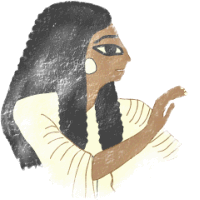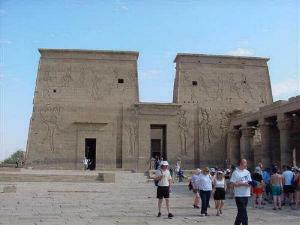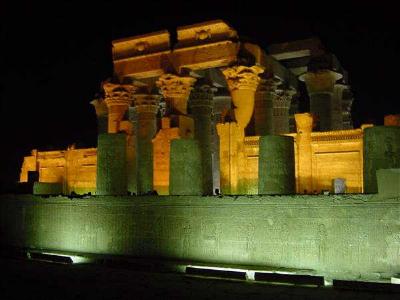An Egyptian Tale: Part Three
Created | Updated Nov 11, 2002

Munchkin and Toccata sail down the Nile, keeping an eye out for any Belgian detectives.
Day 5
Up early again for a trip to Philae. I think temple fatigue may now be setting in as I struggle to get excited about being up before six. Anyhoo the Temple of Isis at Philae is the temple that was famously rescued from the waters after the building of the dams at Aswan. Comparing it in its new position with David Robert's paintings of the original show what a good job they have done. Sadly, due to the temple not being rescued until the seventies, and the waters having started to rise from as soon as the British Dam was built in 1902, there are now tide marks around the walls of the temple. Indeed these tide marks stretch up to a good fifteen to twenty feet up the walls, but it seems to have dried out well.

There is one change to the temple due to its move. When clearing the new island on which the temple was to sit a small, previously unknown, temple to Hathor was found. This has now been incorporated into the second pylon, causing a slight twist in the major axis of the temple. Hence sunlight no longer shines into the sanctuary.
Also of interest here is that Philae was heavily used by early Christians and hence has an altar and a large number of Coptic crosses carved over the hieroglyphics. Vandalism perhaps, but now as much part of the temples ancient heritage as anything else.
As the time came to leave Philae we were shown the Nileometer. Now this is a well or sloping tunnel, depending on the temple, which was used to chart the level of the Nile through the seasons. This one sticks in my mind for an entirely modern reason however. As myself and Toc were looking quizzically at it one of the security guards approached us. I was forced to assume he was a security guard, even though he was in plain clothes due to the fact he had been talking to a uniformed guard and was carrying a sub machine gun. Anyhoo, he walked up to us and gestured at the dark tunnel while muttering 'See, see' which appeared to be the extent of his English. As he had a gun, and there were no other tourists around we some what reluctantly went down, out of sight, into the tunnel. He then pointed at the walls with his gun and said 'Egypt, Roman, Christian, Muslim, Egyptian' while pointing higher, which didn't mean a lot to me at the time. Then he pointed at my camera and made 'Give me' motions while his gun lazily swung on its strap in my general direction. I gave him my camera and tried not to get upset about all the photographs on it I was about to lose. At that point getting back out of the tunnel would suit me fine. He then took a photograph of myself and Toccata, who did a fine impression of rabbits in headlights, gave me back my camera and led us back outside. I was so glad to see the sun light again that I lost all my inhibitions about baksheesh and paid up. After all, he still had that gun. We then hurried off, making a mental note to look up the guide book and find out what on earth I had just paid to see.
Then on to a propaganda lesson at the High Dam. The High Dam is an astounding piece of modern engineering which the Egyptians are rightly proud of. It has allowed modern Egypt to build firm, permanent foundations and a modern infrastructure without the fear of the annual flood and with an abundance of cheap hydroelectricity. Unfortunately it has also led to a steep increase in artificial fertilizer use, the drowning of the ancient country of Nubia and the displacement of its people and loss of its monuments. Also the lake behind the dam is now silting up with the annual inundation and there is much concern about what will happen in the long run. However, this being an Egyptian tour guide he concentrated on the positives and reminded us all how evil Anthony Eden was for conspiring to stop the building of the dam in the first place and then invading the Suez canal when it was nationalised to pay for its construction.
Next was a papyrus-making lesson and some beautiful artwork as we were taken to another shopping opportunity. Having been in the country a few days now I had softened somewhat to these practises and came away with a very nice picture of the Egyptian zodiac on what certainly looks like genuine papyrus.
We then took a quick sail on a motor boat out to Kitchener Island. This is a botanical garden, as originally set up by Lord Kitchener, he who failed to save Charlton Heston at Khartoum, and makes for a very odd juxtaposition with the Aga Khan's mausoleum which is on the far bank. Kitchener Island, is wonderfully shady and green and yet you can look across at the far bank where a hill rears up and the Aga Khan lived and is buried, burying himself in the sand every so often to cure his rheumatism, and where nothing grows at all. Unfortunately it was getting towards midday and hence far too hot, even under the trees and so we rapidly tired and returned to the boat.
The afternoon was free and so Toccata and myself took ourselves off to the souk. Sadly we only saw the tourist souq as, by the time we had been harangued by an entire block of stalls we had had enough. We did buy some souvenirs, but only from the one shop that genuinely gave us no hassle, rather than just proving they knew the words by repeating them every two minutes as they shouted at us. This spending in hassle free shops would become a habit, and certainly one I was happy to pay a little extra for.
A very early night was had this night as the next morning would see us going to Abu Simbel, with a wake up call at three fifteen in the morning.
Day 6

How we got up and got to Aswan airport I can't remember. I could barely remember my name at that time in the morning, and I certainly struggled with the idea of security checks as we came into the airport. Luckily we were on the first flight out and so the airport was deserted. This didn't stop there being a delay in the flight leaving, but I think this was partially due to our group being late, so I can't complain. The plane eventually left Aswan at five in the morning and arrived half an hour later in Abu Simbel 'International' airport. I had woken up by this point as it felt like our pilot had only just stopped flying for the air force and was expecting the Israeli's any day. Still, he got us safely down, if rattled, and we piled off and onto a bus to the temple which drove down to the lake as the sun rose over the eastern desert.
We are led around to the facade of the two temples at Abu Simbel originally cut into the rock of the cliff face and all is forgotten. The early morning no longer counted and I was wide awake and in awe. I had hoped to record my first words on seeing the great temple here but sadly all I could think of to say was; 'That's big!', so bang goes that piece of travel-writing technique.
30m high, 3½ Rameses gaze down over you and the Nile/Lake Nasser and make you want to bow down and apologise for even thinking of looking their way. Rameses II conquered and no one will ever forget. Try as I might I cannot think of an adequate way to describe the sight so you will just have to go and see it yourselves.
Inside is a warren of rooms and halls, colours still visible as Rameses wins the various battles of his reign against the Hittites and Nubians. And right at the end sit 4 gods, Ra-Herakty (it is his temple technically), Rameses II (still alive when made a god), Amun and Ptah (never lit by the sun). I could spend hours inside and further hours outside this temple and be happy. Probably dead from heat exhaustion too.
Next to the temple of Ra-Herakty is a second smaller also rock cut temple to Hathor with further huge statues which are hard to appreciate after the 'large' temple. What makes these temples all the more impressive is that they were moved sixty five metres higher up the banks of the Nile as Lake Nasser grew. Being as they were cut from solid rock, rather than built from blocks like Philae, this was a massive undertaking, to chop an entire mountain into blocks and lift it to its new home. Quite possibly worthy of the original builders three thousand years before. It was getting hot and busy so we left and caught the half eight flight back. It was thirty eight degrees at the airport when we left. I will go back.
Back on the boat we had to wait for the air conditioning to be fixed and then went to bed - which was much needed after the exertions of the morning.
Getting up later we had a quiet afternoon watching more Nile farmers and fishermen, as well as the ubiquitous shouting children, slide past. Why all the children on the banks shout at the boat I have no idea. There are over two hundred cruise boats on the Nile, almost all of which make the same journey as us and, except at a few points, we are too far from the bank to do anything but wave. Yet almost every child we passed shouted and waved. I am a bit worried they expected us to pull in, take them on board and whisk them off to a rich, Western lifestyle or something, when all most of the passengers were for doing was waving at the funny Egyptian kids.

Anyhoo, that evening we arrived in Edfu and the Temples of Sobek and Horus. Not much left to see other than some architectural niceties. Edfu had another nileometer for measuring floods, luckily without the gun toting addition, and some low walls which allowed us to see how the builders held their buildings together. Each block was manoeuvred into position and finished such that it fit perfectly. Then a bow-tie shape was cut across two adjoining blocks and a wooden dovetail was hammered into place, holding the two blocks together. Edfu has many of these bowtie shapes to see, but sadly no dovetails, as early visitors pinched them all.
Edfu also had a crypt under the sanctuary which it is believed was used by a priest to pretend to be a god and speak back to the Pharaoh when he was worshipping.
Off to one corner was a small building with two glass cases containing two mummified crocodiles. Every year crocodiles were caught, allowed to fight and the winner was mummified and worshipped to ward off crocodile attacks on the priests as they crossed the river to gather herbs for the hospital that was believed to have existed as part of the Horus temple.
This extremely long day finally finished with an Egyptian buffet in Gabyihas. A Gabiyah is the long shirt worn by the majority of Egyptians and we were encouraged to acquire ourselves one for the evenings entertainment. Most people joined in, the Egyptian buffet was excellent, especially a sort of bread and butter pudding but with added rice which I loved, and the dining room looked very colourful. However I was far too tired to take part for long so snuck off to my room to remove the bed sheet man the staff had left and then pass out.
An Egyptian Tale: Part One
An Egyptian Tale: Part Two
